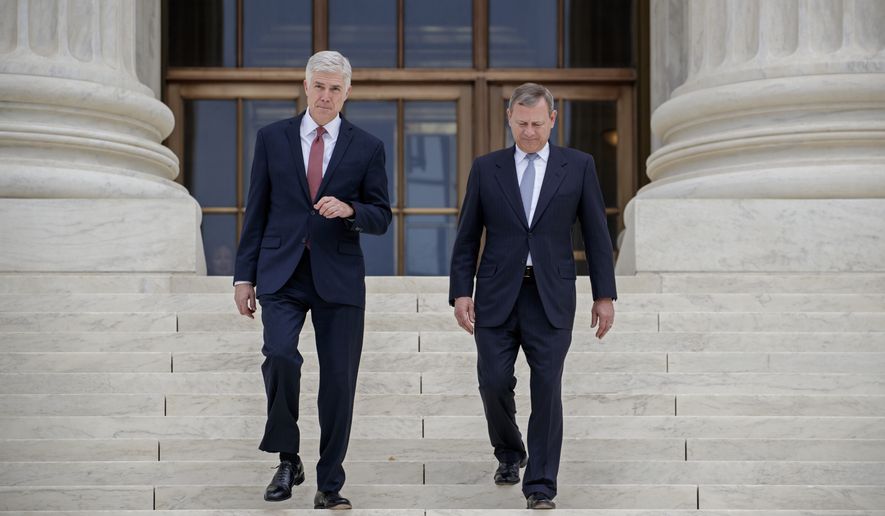An understaffed U.S. Supreme Court left justices with a boring docket this year, but legal analysts said the addition of Justice Neil M. Gorsuch promises to make the next term, beginning in October, a blockbuster.
Already on tap for the court are President Trump’s travel limits for some countries — a case that could reset the limits of presidential powers — as well as another round in the battle between gay rights groups and devout Christians.
The justices also have agreed to hear a challenge to Wisconsin’s gerrymandered legislative districts, a case that could fundamentally change the balance of power on Capitol Hill and in statehouses across the country.
It’s a much heftier caseload than the just-concluded term, in which the biggest cases involved trademark law and a limited question on churches’ access to government funds.
Reviewing the just-finished session, legal scholars said the court shied away from big cases.
“For three-quarters of the term, it was a justice short, so that makes it lame,” said Robert Tuttle, a law professor at George Washington University. “It did hold off on taking a number of cases.”
Perhaps because of the smaller court, the justices took fewer cases this term, considering just 71. They heard 82 cases in the 2015-2016 term, which could have impacted the lower number of high-profile cases heard this year.
Mr. Tuttle said he expects the next term to have more “flashy” rulings.
Amid a lack of headlining cases, Justice Gorsuch’s confirmation to the seat left vacant by the death of Justice Antonin Scalia was the biggest news out of the high court. In his two months on the bench, Justice Gorsuch made a splash with his eagerness to get involved, writing forceful opinions on several decisions.
Elizabeth Wydra, president of the Constitutional Accountability Center, said business interests also are doing well in the high court when judged by cases in which the U.S. Chamber of Commerce took a stance.
“We have found over all that [Chief Justice John G.] Roberts’ court is the most pro-corporate in the modern era, but this term the Chamber had a whopping 80 percent success rate in the Supreme Court,” said Ms. Wydra. “So, that I think is a remarkable consolidation of power for the business lobby in the Supreme Court this term.”
With an eight-member court, the justices managed to find more unanimity. Some 59 percent of their cases were decided without dissent, compared with 48 percent unanimity during the previous term, when Scalia was on the bench.
Thomas Goldstein, a partner at Goldstein & Russell and co-founder of SCOTUSblog, said he expects less unanimity now that the court has returned to nine justices and because of its caseload.
“It’s extremely likely over the next few terms you will get historically high, ideologically fractured 5-4 decisions,” said Mr. Goldstein.
He said Justice Gorsuch could be a big factor.
“With Justice Gorsuch, I think we’re going to see a down-the-line doctrinaire conservative, to the right of Justice [Samuel A.] Alito even,” said Mr. Goldstein. “Justice Gorsuch brings a renewed, a strong, conservative energy that actually Justice Scalia had kind of passed.”
One case that might get an ideologically divided split involves a Christian baker who ran afoul of a Colorado civil rights panel after refusing to bake a cake for a same-sex wedding. The case had been pending before the court since last year, but the justices agreed only last week to hear it, leaving court watchers speculating about why it took so long for the justices to take it up.
“About the only thing you can say for sure is that the justices are closely divided and that they feel strongly about the issues,” said John Elwood, a lawyer and SCOTUSblog writer.
The case was put on the docket two years after the Supreme Court decided that same-sex couples have a constitutional right to marriage.
Analysts said the bakery case could show how far the justices want to go in the clash between gay rights and religious beliefs.
“It is something that affects not just the litigants, but it is the kind of thing we are seeing over and over again across the country,” said Carrie Severino, chief counsel at the conservative Judicial Crisis Network.
The travel limits could overshadow everything else at the beginning of the court’s term — if the justices ever get to it.
In their first go-around last week, the justices allowed part of the 90-day halt on visitors from six majority-Muslim countries to take effect. If Mr. Trump uses the time to come up with a new vetting plan, as he said when he issued the order, then the travel limits could expire by the time the court convenes in October.
“By then, [the administration] may have had the chance to do that analysis and come up with a totally different approach,” Ms. Severino said.
Michael Moreland, a law professor at Villanova University, said a political gerrymandering case from Wisconsin also could have high impact.
The court will decide whether or not it should review and restrict the state legislatures’ decisions with regard to partisan gerrymandering.
• Alex Swoyer can be reached at aswoyer@washingtontimes.com.




Please read our comment policy before commenting.